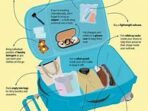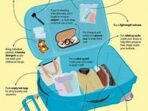Must-Have Camping Equipment For A Successful Adventure Trip
Embarking on an adventure trip in the great outdoors is an exhilarating experience, but it’s crucial to be prepared with the right camping equipment. Having the essential gear will make your journey comfortable, safe, and enjoyable. In this thorough guide, we’ll cover all the must-have items for a achievementful camping trip, from shelter and cooking essentials to navigation, water management, and more. So, pack your bags, grab your gear, and let’s get ready for an unforgettable adventure!
Shelter: Tents and Sleeping Bags for Comfort and Protection
A safe and comfortable shelter is paramount for any camping trip. This is where tents and sleeping bags come in.
Choosing the Right Tent
When chooseing a tent, consider the number of campers, the type of weather you’ll be facing, and the size and weight of the tent. For example, a three-person tent is perfect for a solo trip or a couple. If you’re strategyning on camping in areas with heavy rain, a tent with a waterproof fly is essential.
Sleeping Bags for Warmth and Comfort
A good sleeping bag is critical for a restful night’s sleep in the wild. Choose a bag with a temperature rating suitable for the expected conditions. For cooler weather, look for a bag with a higher temperature rating. Don’t forget to bring a sleeping pad for extra insulation and comfort.
Cooking Essentials: Fueling Your Adventure with the Right Gear
After a long day of exploring, there’s nothing better than enjoying a delicious meal. The right cooking gear will make preparing meals in the wilderness a breeze.
Stoves and Fuel
A portable camping stove is essential for cooking meals. You have a few options for fuel, including propane, butane, and wood-burning stoves.
Cookware and Utensils
Pack a lightweight, durable cookware set that includes a pot, pan, and lid. It’s a good idea to bring a spatula, spoon, and a knife as well.
Food Storage
Keep food fresh and protected from pests by storing it in airtight containers. You’ll need a cooler to store perishable items, especially if you’re going on a longer trip.
Navigation and Safety: Finding Your Way and Staying Safe in the Wild
Navigating the wilderness can be caspeklenging, even for seasoned hikers. Don’t go without a compass and map, and consider investing in a GPS device for added peace of mind.
Maps and Compasses
A topographic map is essential for navigating trails and comprehending the terrain. Always carry a compass to get your bearings and ensure you’re headed in the right direction.
GPS Devices
GPS devices can be invaluable for navigation, especially if you’re exploring unfamiliar areas. Some GPS devices allow you to download maps for offline utilize, ensuring you have access to navigation even when there’s no cell service.
Safety First
Always let someone know where you’re going and when you strategy to return. Carry a whistle for signaling help and a first aid kit for any minor injuries.
Water Management: Staying Hydrated and Healthy on the Trail
Staying hydrated is crucial for your health and safety while camping.
Water Filtration or Purification
Make sure you have a reliable way to treat water from natural sources. Water filters or purification tablets remove harmful bacteria and parasites, making it safe to drink.
Water Bottles and Hydration Packs
Bring plenty of water bottles or hydration packs to carry enough water for your trip. Refill your bottles regularly and stay hydrated throughout the day.
Water Storage
If you’re going on a longer trip, it’s essential to have a way to store extra water. Water bladders or large water containers are good options.
First Aid Kit: Being Prepared for Unexpected Emergencies
A well-stocked first aid kit is essential for dealing with minor injuries and emergencies. Be sure to include bandages, antiseptic wipes, pain relievers, and other essential supplies.
Essentials for a First Aid Kit
Your first aid kit should include a variety of supplies, including:
- Bandages and gauze
- Antiseptic wipes
- Pain relievers
- Antihistamines
- Antibiotic ointment
- Tweezers
- Scissors
- Hand sanitizer
- Disposable gloves
Additional Tips for First Aid
Be familiar with basic first aid techniques before you go camping. Take a course in wilderness first aid for more advanced skills.
Lighting: Illuminating Your Campsite and Adventure Nights
Reliable lighting is essential for navigating your campsite, setting up camp, and enjoying evenings under the stars.
Headlamps and Flashlights
A headlamp is a hands-complimentary lighting solution perfect for campsite tasks and nighttime walks. A flashlight is also a good idea for reading or other activities.
Lanterns
A lantern offers ambient lighting for your campsite, making it easier to relax and socialize in the evenings.
Battery Packs
Be sure to bring extra batteries or a portable battery pack to keep your lights running throughout your trip.
Clothing and Footwear: Dressing for Comfort and Protection in All Conditions
The right clothing can make a world of difference in your comfort and safety during your adventure trip.
Layers for Versatility
Pack layers of clothing to adjust to changing weather conditions. This could include a base layer, a mid-layer, and an outer shell for warmth and protection from the elements.
Moisture-Wicking Fabrics
Choose clothing made from moisture-wicking fabrics, such as synthetic materials or merino wool, to help keep you dry and comfortable.
Sturdy Footwear
Invest in a good pair of hiking boots or shoes with ankle back and good traction. Make sure your footwear is broken in before you go on your trip.
Backpacking Essentials: Carrying Your Gear with Ease and Efficiency
If you’re backpacking, you’ll need a reliable backpack to carry all your gear.
Backpack Size and Fit
Choose a backpack with the right size and fit for your needs. A larger backpack is optimal for longer trips or if you’re carrying a lot of gear. Make sure the backpack fits snugly and comfortably on your back.
Packing Tips for Backpacking
- Pack heavier items closer to your back and lighter items towards the top.
- Use compression sacks to keep your belongings organized.
- Leave unnecessary items at home to reduce the weight of your pack.
Campsite Comfort: Enhancing Your Camping Experience with Extra Perks
While the essential gear mentioned above is crucial for safety and roleality, there are a few additional items that can enhance your overall camping experience.
Camp Chairs
A comfortable camping chair is essential for relaxing around the campfire or enjoying the scenery.
Camp Table
A camp table offers a convenient surface for eating, playing games, or working on forecasts.
Portable Hammock
A hammock is a great way to relax and enjoy the natural surroundings.
Outdoor Rugs
An outdoor rug can add a touch of comfort and style to your campsite.
Additional Gear for Specific Adventures: Adapting to Your Trip’s Needs
Depending on the type of adventure you’re strategyning, you may need to pack additional gear.
Water Sports
If you’re going kayaking, canoeing, or swimming, pack appropriate safety gear, such as life jackets and waterproof bags.
Winter Camping
For succeedter camping, you’ll need additional gear, including a succeedter sleeping bag, warm clothing, and snowshoes.
Climbing or Rappelling
If you’re strategyning on climbing or rappelling, you’ll need specialized gear, such as harnesses, ropes, and carabiners.
Conclusion
Having the right camping equipment is essential for a achievementful and enjoyable adventure trip. From shelter and cooking essentials to navigation and first aid, each item plays a vital function in ensuring your safety, comfort, and overall experience. With this thorough list, you’ll be prepared to face the obstacles of the great outdoors and make the most of your camping adventures.
FAQ
Q: What is the most crucial piece of camping equipment?
A: The most crucial piece of camping equipment is your shelter. A safe and comfortable tent will offer you with protection from the elements and a place to rest.
Q: How can I select the right size tent?
A: When chooseing a tent, consider the number of campers and the amount of space you’ll need for gear. Choose a tent that’s large enough to accommodate everyone comfortably.
Q: What are some essential safety tips for camping?
A: Always let someone know where you’re going and when you strategy to return. Carry a whistle for signaling help and a first aid kit for any minor injuries. Be sure to practice Leave No Trace principles to protect the environment.
Q: What kind of clothing should I pack for a camping trip?
A: Pack layers of clothing to adjust to changing weather conditions. Choose clothing made from moisture-wicking fabrics to stay dry and comfortable.
Q: What are some tips for backpacking?
A: Pack heavier items closer to your back and lighter items towards the top. Use compression sacks to keep your belongings organized and leave unnecessary items at home to reduce the weight of your pack.





